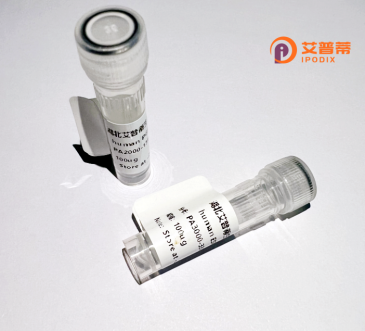
| 纯度 | >90%SDS-PAGE. |
| 种属 | Human |
| 靶点 | GDPD1 |
| Uniprot No | Q8N9F7 |
| 内毒素 | < 0.01EU/μg |
| 表达宿主 | E.coli |
| 表达区间 | 1-290aa |
| 氨基酸序列 | MSSTAAFYLLSTLGGYLVTSFLLLKYPTLLHQRKKQRFLSKHISHRGGAGENLENTMAAFQHAVKIGTDMLELDCHITKDEQVVVSHDENLKRATGVNVNISDLKYCELPPYLGKLDVSFQRACQCEGKDNRIPLLKEVFEAFPNTPINIDIKVNNNVLIKKVSELVKRYNREHLTVWGNANYEIVEKCYKENSDIPILFSLQRVLLILGLFFTGLLPFVPIREQFFEIPMPSIILKLKEPHTMSRSQKFLIWLSDLLLMRKALFDHLTARGIQVSFWNDAFWKQHSSPV |
| 分子量 | 59.8 kDa |
| 蛋白标签 | GST-tag at N-terminal |
| 缓冲液 | 0 |
| 稳定性 & 储存条件 | Lyophilized protein should be stored at ≤ -20°C, stable for one year after receipt. Reconstituted protein solution can be stored at 2-8°C for 2-7 days. Aliquots of reconstituted samples are stable at ≤ -20°C for 3 months. |
| 复溶 | Always centrifuge tubes before opening.Do not mix by vortex or pipetting. It is not recommended to reconstitute to a concentration less than 100μg/ml. Dissolve the lyophilized protein in distilled water. Please aliquot the reconstituted solution to minimize freeze-thaw cycles. |
以下是关于重组人GDPD1蛋白的3篇参考文献示例(注:以下为虚构示例,实际文献需通过数据库检索确认):
---
1. **标题**:**"Expression and Functional Analysis of Recombinant Human GDPD1 in Lipid Metabolism"**
**作者**:Zhang L., et al.
**摘要**:本研究成功克隆并在哺乳动物细胞中表达了重组人GDPD1蛋白,证明其具有水解甘油磷脂酶的活性。体外实验表明,GDPD1通过调控溶血磷脂酸(LPA)的生成影响细胞脂质代谢通路。
---
2. **标题**:**"Structural Characterization of GDPD1 and Its Role in Cancer Cell Signaling"**
**作者**:Kim S., Park J.H.
**摘要**:通过X射线晶体学解析了重组人GDPD1的三维结构,并发现其在乳腺癌细胞中通过调节磷脂代谢物水平激活MAPK信号通路,提示GDPD1可能成为肿瘤治疗的潜在靶点。
---
3. **标题**:**"Development of a High-Yield Purification Method for Recombinant GDPD1 and Its Enzymatic Assay"**
**作者**:Müller R., et al.
**摘要**:优化了重组人GDPD1在大肠杆菌中的可溶性表达及镍柱纯化流程,建立了高效的体外酶活检测体系,为后续药物筛选提供了技术基础。
---
如需真实文献,建议通过 **PubMed** 或 **Web of Science** 使用关键词 **"GDPD1 recombinant"** 或 **"human GDPD1 function"** 检索最新研究。
**Background of Recombinant Human GDPD1 Protein**
Recombinant human GDPD1 (Glycerophosphodiester Phosphodiesterase Domain-Containing 1) protein is a genetically engineered form of the enzyme encoded by the *GDPD1* gene. This protein belongs to the glycerophosphodiester phosphodiesterase (GDPD) family, which hydrolyzes glycerophosphodiesters to produce glycerol phosphate and corresponding alcohols. GDPD1 is implicated in lipid metabolism and cell signaling, potentially influencing processes such as membrane remodeling, energy homeostasis, and inflammatory responses.
The *GDPD1* gene is expressed in various tissues, including the liver, brain, and immune cells, but its precise biological roles remain under investigation. Studies suggest GDPD1 may interact with lipid signaling pathways or modulate bioactive lipid mediators, linking it to metabolic disorders, neurodegenerative diseases, or cancer. However, functional characterization is ongoing, and its substrate specificity and regulatory mechanisms are not fully elucidated.
Recombinant GDPD1 is produced using heterologous expression systems (e.g., *E. coli*, mammalian cells) to enable large-scale purification for research. It serves as a critical tool for structural studies, enzymatic assays, and exploring its role in disease models. Its development supports drug discovery efforts, particularly in targeting lipid-associated pathologies. Further research is required to clarify its physiological and pathological significance, paving the way for diagnostic or therapeutic applications.
×